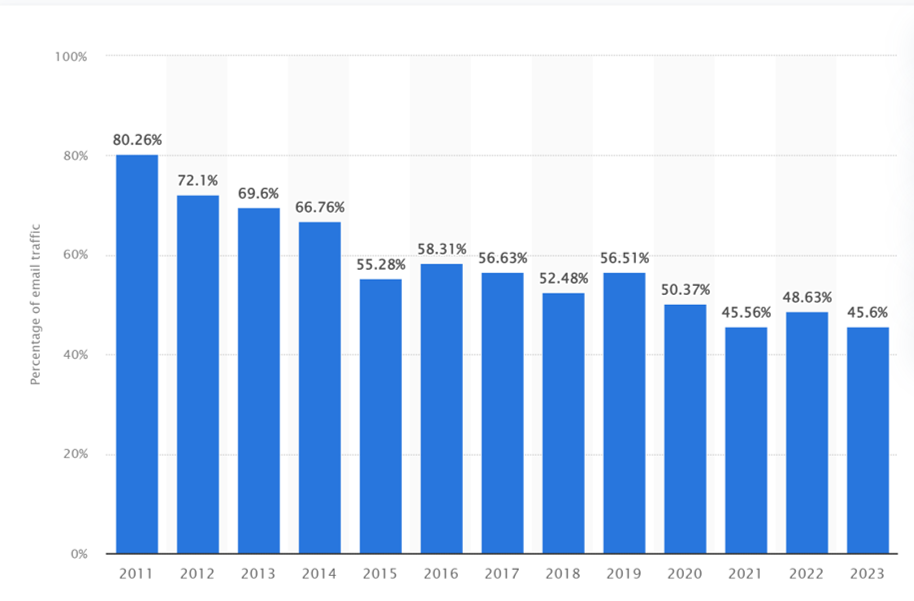- Home
- Solving Problems
- Spam Traps: What Email Markete ...

According to Statista, nearly half of all emails sent worldwide in 2023 were marked as spam. It sounds strange, don’t you think? Makes you wonder how on earth that much junk mail is being sent by so many people!
Global Spam as a Percentage of Total Email Traffic (2011-2023)
Well, the truth is, not all of those emails were truly spam. We know this because research shows that about 21% of emails from legit marketers somehow end up in the spam folder. Sometimes, the problem is not bad luck like you might think. The actual problem might be spam traps.
Spam traps are—like the name suggests—traps disguised as email addresses. Some people call them “honey pots” because they are meant to lure spammers. However, if, as a legitimate marketer, you accidentally add one to your mailing list, it can really mess things up.
We’re talking about lower delivery rates, a damaged sender reputation, and even blacklisting. Read on as we explain in detail how you can avoid these traps.
And, if you think you might have already taken the cheese—we’ve got some fixes for that too.
What Is a Spam Trap?
A spam trap is an email address usually created to identify and monitor unsolicited emails.
While they may look real, spam traps are typically non-responsive. They do not belong to a real person (at least at the time), and so they typically cannot send or reply to messages. Since they do not belong to anyone, they also cannot opt-in to get promotional emails.
Therefore, if, for some reason, you have these addresses on your list, we all need to ask you—how did they get there? Not to judge; it’s either you are not keeping to the rules of seeking permission first, or you are simply not keeping a healthy list.
That said, spam traps, like mouse traps, come in different shapes and sizes. The following are the main categories:
Pristine traps
Like the name suggests, a pristine spam trap is an email address that has never been assigned to anyone. Such emails were created solely to trap spammers.
These emails are usually embedded in websites. And since they are not assigned, it is almost impossible for anyone to have them except through dubious means. To get such emails, one has to scrape the website where they are located.
Of all the types available, this is the most dangerous for your sender’s reputation. If you have these emails on your list, it is crystal clear that you built your list using questionable practices. Either you bought the addresses, or maybe you scraped them yourself.
Recycled traps
Also true to their name, recycled traps are genuine email addresses that are repurposed for traps. These emails used to belong to people but are no longer used.
For instance, let’s say some of your contacts that used to work somewhere but no longer work there. To catch spammers, some companies repurpose these emails and make them spam traps.
While pristine traps are specifically for spammers, these ones target spammers and “legitimate” marketers with poor email hygiene. The idea behind it is that if you keep sending an email to an address that is unresponsive for a year, you should ask questions.
If you are not asking questions, you are either a spammer or a marketer who doesn’t care.
Typo traps
Typo traps are addresses that contain obvious and deliberate errors in their domains (e.g., “gmial.com” instead of “gmail.com”). Of course, this raises the important question: What if it was a mistake?
Well, sending an email to the wrong address one time could be regarded as an error. But when you repeatedly send emails to an address that normally should not exist, it can raise some dust. Either you do not clean your list regularly or you use questionable list acquisition methods. Anyway, these traps are usually not as dangerous as the other two.
How spam traps end up in email lists
Spam traps can infiltrate email lists through various means:
- Purchasing email lists (a practice strongly discouraged in ethical email marketing).
- Scraping websites for email addresses.
- Using old, uncleaned email lists.
- Failing to verify email addresses at the point of collection.
- Not implementing proper opt-in processes.
The Consequences of Hitting Spam Traps
As we already established, different spam traps carry different levels of danger. As such, the damage a spam trap will have will depend on the exact type that you hit and how many times you hit it. Also, the policy of the company behind the trap matters.
Hypothetically speaking, here are some things that could happen if you hit a spam trap:
- Your sender reputation gets reduced, which is like getting a bad credit score in the email world. When this happens, your whole email strategy is affected. Your carefully crafted messages start bouncing back or sneaking into spam folders instead of landing in inboxes where they belong. It’s a domino effect—fewer people see your emails, so open rates and click-throughs drop. Before you know it, engagement with your campaigns is in a nosedive.
- Your IP address could get flagged, and that’s bad news for everyone using the same IP. This means deliverability for all customers using that IP address may drop as well.
- If you accidentally email a spam trap set up by a big email provider (think Gmail or Outlook), they might decide your domain isn’t trustworthy anymore. They might decide to permanently put you on a sending blocklist.
- Hitting traps (especially pristine types) managed by anti-spam organizations can be even worse. In this case, you might have issues reaching inboxes across many different email services.
How to Identify Potential Spam Traps
If you are looking for how to find spam trap email addresses, you need to look closely at the emails on your list. Spam trap email addresses typically look like this:
- Email addresses with no specific name (e.g., info@domain.com, admin@domain.com).
- Addresses that haven’t engaged with your emails for an extended period (6 months to 1 year).
- Addresses with obvious typos in common domains.
While these may or may not mean that an email is a trap, they are pointers that may show the email is suspicious. To ensure you are not making a mistake by deleting a potential reader from your list, the following are some tools and techniques to help you verify even further:
- Email verification services that can flag potentially dangerous addresses.
- Engagement analysis to identify long-term inactive subscribers.
- Regular list cleaning and hygiene practices.
- Monitoring of bounce rates and spam complaints.
Best Practices for Avoiding Spam Traps
Just like rats learn to steer clear of traps, smart marketers know the best strategy is to avoid email traps altogether by doing the following:
Regular validation of email lists
Regularly cleaning and validating your email list is one of the most effective ways to avoid spam traps. But wait, cleaning on your own can be time-wasting and pointless—how do you clean something you can’t identify?
To avoid wasting time, smart marketers use third-party tools like Sendigram Email Checker to clean their list.
Sendigram Email Checker is particularly effective because it employs artificial intelligence technology to validate email addresses and spot any spam trap email addresses. When an address is misspelled, the program provides you with recommendations to fix the address using AI technology.
It is easy to use and risk-free—all you need to do is upload a list of emails, and it tells you which one is a spam trap email with a detailed report.
Avoid purchasing lists
It’s tempting to buy email lists for quick growth, but this often backfires. Purchased lists frequently contain outdated, invalid, or trap addresses. Instead of buying lists, focus on building your list organically through legitimate opt-ins.
Proper segmentation and targeting
Your subscribers are not the same, so you shouldn’t give them the same treatment. We recommend that you sort your list into sections according to engagement levels, preferences, and behavior. This enables you to send valuable and pertinent information to your active subscribers alone.
Encouraging and maintaining engagement
Consider having re-engagement campaigns if you notice some members on your list haven’t received your emails in a while. After several tries, no answer? They should probably be taken off your list because the dormant address could turn out to be a trap.
Implementing double opt-in processes
You should also consider having a double opt-in procedure where users confirm their email address after registering. It helps pick out typos or phony addresses that could be traps and guarantees you’re addressing the appropriate people.
Recovering from Spam Trap Hits
Before anything else, you should stop all email communications and try to find out what went wrong. Once you understand the nature of the problem, it’s time for some serious cleaning.
Strip out all those suspicious and inactive addresses from your list. If it looks suspicious, let it go—no mercy!
While you’re at it, take a hard look at how you’re collecting and validating emails. Maybe it’s time to tighten up those processes.
Once everything is in order, you will also need to rebuild your sender reputation by following these steps:
- Restart your campaign, but this time ensure your list is clean with only valid emails.
- Your email content should be high-quality and engaging, focused on improving subscriber interaction.
- Gradually increase your sending volume to demonstrate consistent, positive sending behavior.
- Monitor your sender score and deliverability metrics closely.
- Finally, be patient—rebuilding a damaged reputation can take weeks or even months.
To Sum Up
As you can see, spam trap email addresses can make significant negative impacts on your marketing strategy. However, if there is any takeaway from this article, it should be the fact that following ethical email practices is the best way to avoid spam traps.
If you are willing to put in the extra work to build your list—ethically and organically, you will likely have no issues with these traps. And if by mistake you fall into one of these traps, you can always return to this article to find the help that you need.




